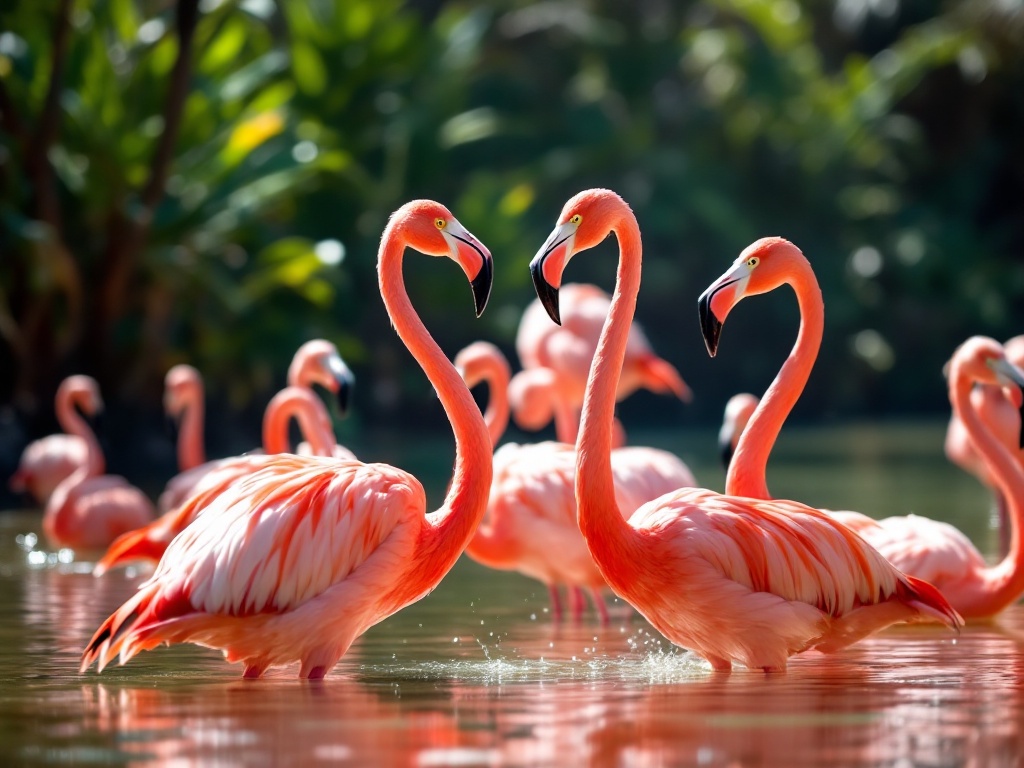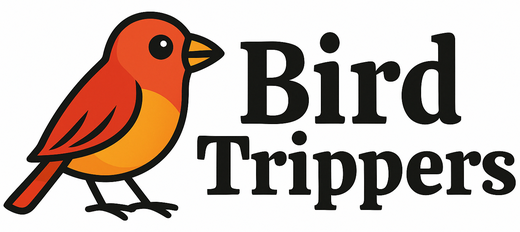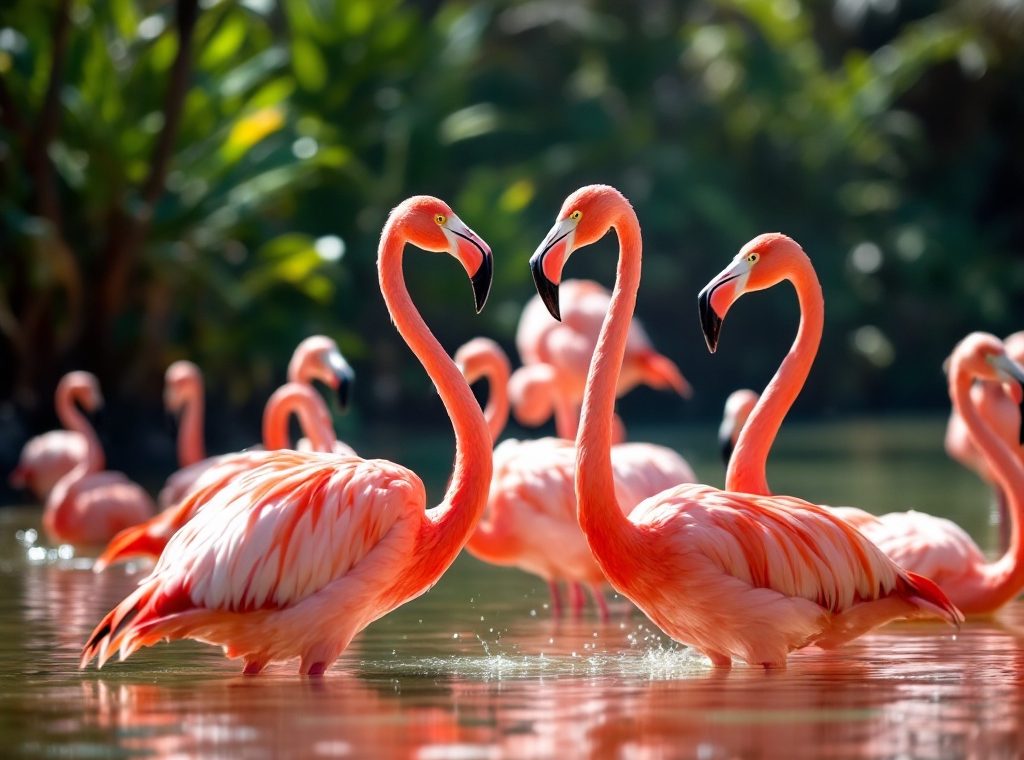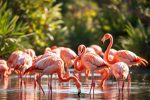Are Flamingos Aggressive: Get to Know These Pink Birds
Ever wondered why flamingos are so pink? It’s more than just a pretty color—it’s a sign of aggression! Discover how the intensity of a flamingo’s pink plumage directly relates to its dominance and competitive behavior, especially when vying for food. Explore the fascinating link between color, diet, and social status in flamingo flocks, and learn how these vibrant birds maintain their pecking order. Delve into the world of flamingo aggression and uncover the secrets behind their vibrant hues.
Important information

- Brighter pink flamingos tend to be more aggressive, especially when competing for food.
- The pink color comes from carotenoids in their diet, which may influence hormones and behavior.
- This vibrant plumage signals health and dominance within the flock, influencing social hierarchy.
- Competition for food can trigger aggression, but providing ample space reduces conflict.
- Dominant, brightly colored flamingos secure the best feeding spots and eat first.
Are Flamingos Aggressive?
When competing for food, flamingos can exhibit aggressive behavior. The intensity of their pink plumage is often correlated with their aggression levels, with brighter birds being more prone to initiating confrontations. This observation suggests a link between color vibrancy and aggression in flamingos.
The Role of Pink Color in Flamingo Aggression
A flamingo’s vibrant pink plumage is more than just a pretty color—it’s a badge of status. The brighter the bird, the more aggressive and dominant it tends to be, particularly when competing for food. Studies confirm this link, observing how intensely pink flamingos often muscle their way to the front of the feeding frenzy. This suggests that color plays a key role in establishing the flamingo social hierarchy—the brighter the pink, the tougher the bird.
Why Pinker Flamingos Are More Aggressive
A flamingo’s vibrant plumage signals its health and hunting prowess. The pinker the feathers, the more competitive the bird becomes. This results in securing more food and exhibiting greater aggression, often challenging paler rivals.
Behavioral Ecology: The Influence of Plumage Coloration
A flamingo’s vibrant plumage, derived from carotenoid pigments in their food, may actually fuel their aggression, particularly when feeding. These pigments not only dictate color but could also influence hormones linked to bolder behavior. Conversely, paler flamingos tend to be less aggressive, often foraging in larger, less competitive groups. This color-behavior connection offers valuable insights into the dynamics of flamingo society.
Social Structures and Dominance in Flamingo Flocks
Within flamingo flocks, vibrant plumage indicates high status, with brighter birds holding higher rank. This social hierarchy influences access to essential resources like food and mates. Constant communication, through calls and displays, strengthens social bonds and reinforces this pecking order. These interactions are vital for maintaining group cohesion and coordinating key activities such as feeding and breeding. Dominant flamingos secure the best feeding spots and eat first. While competition for resources can sometimes lead to friction, expressed through pecking and chasing, especially when food is limited, serious fights are rare. Typically, displays of dominance settle disputes, establishing the hierarchy and allowing the flock to function smoothly.
How Dominance Affects Food Competition
Bright pink flamingos dominate, securing the best food and intimidating paler birds. This advantage is clear when food is scarce, highlighting the benefits of their vibrant color.
Understanding Flamingo Feeding Behavior
A flamingo’s diet directly impacts its health and vibrant coloration. Healthy birds feed efficiently, deriving their pink hue from carotenoids found in their food. This bright plumage signals a nutritious diet, primarily consisting of algae, brine shrimp, and small invertebrates. These food sources are typically found in shallow waters, where flamingos use their specialized beaks to filter feed. Often wading in groups, they stir the mud to uncover more sustenance.
Feeding Situations and Aggression
Competition for food, especially in crowded conditions, can make flamingos aggressive. Brighter pink flamingos, whose color indicates a carotenoid-rich diet, are often the aggressors, fighting for both sustenance and status. These skirmishes ultimately reinforce the flock’s hierarchy.
Impact of Captivity on Feeding Aggression
Captivity influences flamingo feeding aggression. Studies reveal that providing more space significantly reduces fighting among flamingos and promotes their natural foraging behaviors. This calmer environment contributes to a more peaceful mealtime atmosphere, fostering the flamingos overall well-being.
Reduced competition for food plays a crucial role in minimizing aggressive behavior during feeding times. Ample space allows flamingos to forage more naturally, reducing stress and promoting healthier interactions within the flock.
Research Studies on Flamingo Aggression
Studies reveal a captivating connection between the vibrancy of flamingo plumage and their behavior. Brighter pink feathers are linked to heightened aggression, especially during feeding and mating rituals. Providing adequate space in feeding areas helps reduce these aggressive behaviors, creating a more harmonious environment for these colorful birds.
Key Findings from Recent Studies
New research reveals that vibrant pink flamingos exhibit more aggressive behavior.
In contrast, paler flamingos tend to be less aggressive, especially within larger feeding grounds. This underscores the significant influence of environmental factors, particularly the size and availability of feeding areas, on flamingo aggression.

















